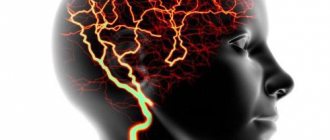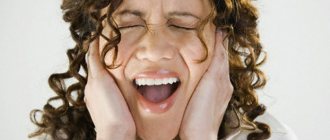Generalized anxiety disorder is not a rare mental illness. This is a constant feeling of anxiety for any reason or even without it. It would seem that a feeling of anxiety or some kind of fear is often present in the life of every person. But somewhere there is that very line, beyond which it becomes almost impossible to control your anxiety and it develops into a disease.
What is GTR
These questions probably haunt those who have noticed causeless anxiety or worry for no particular reason:
- Why is this happening?
- How to distinguish GAD from other mental disorders?
- Who is most susceptible to this disease?
- Is it possible to develop generalized anxiety disorder in childhood or does it only affect adults?
- How to recognize the first symptoms and start treatment on time?
- What modern psychotherapeutic techniques are used to combat the problem?
- Is it necessary to use medications to treat chronic anxiety?
- Is it possible to get rid of the disease forever?
Of course, you don’t need to diagnose yourself yourself - this is the job of a psychotherapist, and interesting information will never be superfluous.
A persistent mental condition called generalized anxiety disorder occurs as uncontrollable worry for no apparent reason. At the same time, the reason for concern may not only be one’s own safety, health or life. Often a patient suffering from chronic anxiety harasses not only himself, but also his closest relatives: spouse, parents, children.
At the initial stage, the disorder looks quite harmless. After all, there is nothing strange in the fact that a person tries to protect himself or his family from troubles. However, this happens only in the first stages of the disease. As a mental disorder develops, being around, and even more so, communicating with such a person becomes more and more problematic.
The fantasy of a patient with chronic anxiety produces strikingly pessimistic pictures and sets up exclusively the worst outcome of any situation. The worst thing is that a person simply cannot put aside restless thoughts and switch his attention to something more positive. At this stage, he needs qualified medical care.
The life motto of a person with GAD is: If I worry about it, it won't happen. He has developed the habit of calculating all actions several steps ahead, and if suddenly some puzzles don’t work out, it’s a disaster.
If depression prevails
Despite the widespread use of antidepressants of various spectrum in the treatment of patients with anxiety-depressive disorder, these drugs are not always effective. This is due both to the peculiarities of the metabolic processes of each individual person, and directly to the true cause of the formation of the disease.
Depression is a complex mental spectrum disorder, classically associated with a disorder of mood, loss of interest in something, life in general, loss of interest in things in which there was interest. There is a feeling of deep sadness and even hopelessness. In this case, one of the first symptoms usually appears is sleep disturbance, sexual satisfaction, and loss of appetite. Further, a person may lose weight, concentration decreases, hearing, vision, and smell decrease. With the further development of the pathology, the symptoms intensify and change. For example, appetite may increase, weight may increase, and a person may develop an illness. Many, unfortunately, begin to drink alcohol as a medicine, which gradually forms alcohol dependence. In such situations, a person’s mental state is complicated by addiction. This complicates the process of treating anxiety-depressive disorder.
It is not uncommon for somatic manifestations to come to the fore. More often they are expressed in rapid fatigue, a feeling of tiredness, headaches, and psychosomatic disorders begin to form. Gastrointestinal disorders, chronic pain, and dizziness develop. This symptomatology can manifest itself to a significant degree and look like a serious somatic disorder. Such people usually turn to various doctors more than once, but cannot establish an accurate diagnosis, and the prescribed treatment did not help much.
Differential diagnosis
Unfortunately, due to the presence of the main complaints of physical illness, anxiety-depressive disorder often goes unnoticed. Many patients are given many different diagnoses that do not truly reflect the state of their health. Due to the phenomenon of somatization, anxiety-depressive disorder is not noticed by doctors.
At the initial stages of diagnosis of patients complaining of physical ailment, which has an unclear cause (not clear etiology) or poorly grouped symptoms, when diagnosis is difficult. Or there are other difficulties in making a complete and accurate diagnosis, we recommend that such patients be referred for examination to a psychotherapist or psychiatrist.
This is due to the fact that in such cases there is a very high probability of developing an anxiety-depressive disorder or other disorders of higher nervous activity, which can manifest themselves in the form of physical ailments.
As a rule, an examination by a doctor and a pathopsychological diagnosis is sufficient to identify or exclude a mental disorder. At the same time, I would like to especially emphasize that this disorder belongs to borderline mental states and the sooner treatment is started, the faster and easier the healing process will be.
Reasons for development
Reasonable fear is, of course, an integral part of everyday life. The instinct of self-preservation is formed on it. But at some point it gets out of control, and a person is no longer able to control it.
All our fears come from childhood. Impaired perception of stressful situations is a consequence of incorrect presentation of information from parents to the child, protection from conflicts and troubles, and excessive care.
The impetus for the development of pathology can be:
- consequences of injury;
- severe, long-term illness;
- divorce of parents or long separation from one of them;
- death of a loved one;
- violence;
- fighting.
In a word, such moments in life, when a person is on the verge of despair and has nowhere to get the necessary support, give rise to the development of generalized anxiety disorder. Characteristic symptoms appear gradually in adults, developing over time and getting out of control.
If a child has not learned basic concepts of safety since childhood, then the likelihood of progression to uncontrollable anxiety increases significantly. The task of parents and other relatives is to teach the child to believe in his own strength and not be afraid of uncertainty. Intimidation, threats and other similar methods of influence are absolutely unacceptable when communicating with children.
Experienced violence of any kind: moral, physical, sexual, never passes without a trace. Similar sensations are experienced by a person who takes direct part in military operations or who becomes an involuntary witness to them. The psyche is failing, and you can’t do without the help of a specialist.
Bad habits are also provocateurs of anxiety. Alcohol and drugs distort the perception of real events. All feelings are heightened, while the instinct of self-preservation, on the contrary, is dulled. During an attack of unjustified anxiety, a person is capable of committing inappropriate actions.
Treatment process
Treatment of anxiety is complex, including psychotherapy, medication and physiotherapy, the use of traditional medicine, normalization of work and rest regimes.
If the syndrome has a mild course, and the patient’s condition remains stable and satisfactory throughout the entire period of the disease, non-drug treatment is carried out.
General recommendations and diet
Experts recommend that patients follow the following rules to alleviate their general condition and speedy recovery:
- Change your lifestyle
- To walk outside,
- Move a lot
- Get enough sleep
- Eat a balanced diet,
- Do not drink alcohol and do not smoke,
- Avoid stressful situations
- Learn to relax
- Breathe correctly
- Chat with people, meet friends,
- Train your brain and stay calm.
Patients need to eat a balanced diet, excluding fatty, spicy, salty, smoked, and fried foods from the diet. For normal functioning, the body must receive all the necessary nutrients. If you are deficient in certain elements, you should periodically take multivitamin complexes and dietary supplements. It is useful to eat fruits and vegetables, dairy products, beef, seafood, nuts and other foods that have a beneficial effect on a person’s emotional state and contain vitamins that help the brain work.
Psychotherapeutic influence
The main goal of psychotherapy is to teach the patient to cope with his problem, block it independently and control the emotions that lead to an anxiety disorder.
Experts choose the method of psychotherapeutic treatment depending on the etiology of the disease and the clinical picture. The most effective psychotherapeutic techniques for anxiety syndrome:
- Psychoanalysis,
- Cognitive psychotherapy,
- Behavioral psychotherapy,
- Rational psychotherapy,
- Hypnosis, suggestion.
Psychotherapy replaces negative thoughts and anxious experiences with a joyful and optimistic mood, enhances the effectiveness of psychotropic drugs, eliminates problems with socialization, and reduces the risk of relapse after comprehensive treatment of the syndrome. Psychotherapeutic influence is used to treat patients individually and in groups. Patients learn to behave in difficult life situations and become more confident. The effectiveness of psychotherapy depends on the patient’s desire to cure this condition, as well as on the severity of the syndrome and the presence of concomitant psychopathy. A positive result of treatment is a sustainable change in the patient’s behavior, his adequate reactions to stressful events, memories or planning for his future.
In severe cases, when the syndrome progresses and the condition of patients rapidly deteriorates, they switch to pharmacotherapy.
Medicines, physiotherapy and herbal remedies
Patients are prescribed medicinal correction of the condition using the following groups of drugs:
Tranquilizers - successfully fight panic attacks "Alprazolam", "Clonazepam", "Diazepam",- Neuroleptics - help to forget about excessive anxious feelings “Tiaprid”, “Sonapax”,
- Antidepressants – normalize the functions of the central nervous system and eliminate mood swings “Amitriptyline”, “Anafranil”, “Imipramine”,
- Nootropics - improve blood supply to the brain “Nootropil”, “Pantogam”, “Piracetam”,
- Adrenergic blockers - eliminate heart pain and palpitations “Atenolol”, “Bisoprolol”,
- Adaptive photographic remedies are widely used in the treatment of anxiety syndrome - “Novo-Passit”, “Nervo-Vit”. They have a long-term sedative effect and reduce the severity of autonomic disorders.
Drug treatment eliminates symptoms, bringing only temporary relief. After discontinuation of drugs, recurrence of the disease is possible. Abstinence often develops when psychotropic medications are abruptly stopped.
Physiotherapy for anxiety-depressive syndrome includes the use of low-frequency currents that normalize the functioning of cerebral structures. Electroconvulsive therapy and oxygen therapy have beneficial effects on the functioning of the brain and other vital organs. During rehabilitation, patients are prescribed restorative and soothing massage, acupuncture, physical therapy, and hardening.
Traditional treatment of anxiety and depression is supplemented with traditional medicine after consultation with a doctor. The most commonly used infusions are mint and hawthorn, horseradish, ginseng, angelica, a decoction of oat straw, valerian root, motherwort herb, lemon balm leaves, St. John's wort, and fireweed herb.
Main symptoms of the disease
The main and fundamental symptom of generalized anxiety disorder is fear that does not have a specific focus. This distinguishes it from various phobias that are focused on a specific object. The patient is worried about absolutely everything: from boiling water in the kettle to an alien invasion. Any event can be turned in such a way that its ending will be frightening.
GAD can manifest itself in different ways: in the form of periodic attacks or constantly. A panic attack occurs at the moment when the understanding comes that the situation cannot be controlled or its outcome depends on someone else.
Generalized anxiety disorder often manifests itself with somatic symptoms such as:
- headache;
- dizziness;
- sweating
- pain in the muscles, convulsive spasms;
- increased fatigue, general weakness;
- sleep problems;
- fussiness, restlessness;
- disturbances in the movements of the facial muscles;
- constant pressure.
Low self-esteem inspires confidence that everything is bad and will get worse. Any situation whose outcome is unknown in advance is considered potentially dangerous for a person with generalized anxiety disorder. He must control the situation; uncertainty frightens him very much.
Diagnosis
GAD is characterized by increased anxiety and worry (most days during the past six months) about a variety of events and activities, such as school or work. In addition, GAD is associated with restlessness, muscle tension, fatigue, problems concentrating, irritability and sleep disturbances.
DSM-5 criteria for diagnosing GAD
- Excessive anxiety and worry (anxious anticipation) about a variety of events and activities, such as school or work.
- The person has difficulty gaining control over anxiety
- Excessive anxiety and worry are associated with at least three of the following symptoms, affecting a person most days for at least six months: Restlessness or feeling on edge, fatigue, difficulty concentrating, irritability, muscle tension or sleep disturbances
Features of mental disorder
It has been observed that generalized anxiety disorder does not develop in childhood or adolescence. Its manifestations become noticeable only after 30-35 years, sometimes earlier. And if the reasons for its formation go back to childhood, then the failure occurs only at a conscious age.
In general, we can distinguish three areas of fear that so worry a person suffering from chronic anxiety.
- Fear of one's own physical death or that of relatives or loved ones. In principle, each individual tries to avoid potentially life-threatening factors. However, a person with GAD sees this threat everywhere, even in the most harmless things. His imagination gives him such scenarios for the development of events that horror movie directors would envy.
- Fear of social inferiority. It lies in the fact that a person is afraid of becoming unnecessary to others, ineffective for society.
- Fear of going crazy. Admitting that you have any mental disorder is very difficult. Therefore, the prospect of losing the ability to reason sensibly and make decisions independently can frighten any person.
GAD is approximately twice as common in women as in men. What is this connected with? To understand the reason, you need to delve into history. Since ancient times, a woman, as the keeper of the hearth, was responsible for almost everything: order in the house, the availability of food, the health of children, etc. Simply put, there was nothing to worry about.
Millennia have passed, but, in fact, little has changed: representatives of the fairer sex are much more susceptible to chronic anxiety than men. And the reasons for this have only increased. But under certain circumstances, a malfunction in the functioning of the psyche occurs, and the exciting state takes on a pathological character.
Treatment options
Only a psychotherapist can prescribe adequate treatment. When determining a diagnosis, a fairly long period of time is required to observe and evaluate symptoms. It usually takes about six months to study a patient's situation. But during this time, it is necessary to exclude the physiological cause of chronic anxiety. To do this, it is recommended to take basic tests and undergo an examination.
Like many other mental disorders, generalized anxiety does not go away on its own. Over time it only progresses. It is very important to get diagnosed and receive the correct treatment.
Mental disorder is not the result of any external factors. It is provoked by their individual perception and subjective assessment of events. Treatment is aimed at fundamentally changing the interpretation of facts, as well as developing pragmatic and rational thinking.
The course of the disease may differ markedly in people of different temperament and character. Based on this and taking into account the patient’s personal characteristics, treatment is prescribed. It could be:
- individual or group psychotherapy;
- medicinal method;
- psychotechnics with elements of relaxation - yoga, qigong, etc.
An integrated approach to the disease has also not been canceled. The most commonly used medications to block the symptoms of GAD in adults are antidepressants. They help replenish missing neurotransmitters: serotonin, dopamine, adrenaline, the insufficient production of which causes anxiety.
With this type of mental disorder, group sessions with a psychotherapist provide positive dynamics. Their importance lies in receiving feedback, the ability to compare someone else's problems with your own. A healthy lifestyle and correct, rational thinking also play an important role.
Generalized anxiety disorder: self-treatment
Work on an anxiety disorder can only be carried out comprehensively - at the level of the body and at the level of thinking. These two areas are inextricably linked and have a huge impact on each other.
Working with the body
One of the most important “bodily” aspects is regular physical activity. Physical inactivity – a sedentary lifestyle – has an extremely negative effect on the psyche. Therefore, the first thing you should do is reconsider your motor stereotype. You can learn more about the connection between sports training and the nervous system here.
This could be giving up personal transport in favor of walking, regularly going to the gym, playing football, tennis or any other sport that is now easy to find for every taste. The main thing is to give your body the physical activity it needs. Regularly and daily. And this is the first factor in successful work on an anxiety disorder.
The second “bodily” factor is the development of the skill of diaphragmatic breathing - or belly breathing. This is a very important point, since incorrect, shallow and “anxious” breathing can provoke acute attacks of anxiety and even panic attacks.
Measured belly breathing, in turn, helps calm the nervous system and saturate the body with oxygen. It can be used in stressful situations, helping you concentrate and reduce anxiety.
The essence of belly breathing is that when you inhale, the stomach inflates due to the movement of the diaphragm, and when you exhale, vice versa. This method uses the fullest volume of the lungs, in contrast to intermittent “anxious” breathing. This is beneficial for both the nervous system and the body as a whole for a number of reasons:
- better resistance to viruses and bacteria is achieved due to better air circulation in the lungs;
- the body is better saturated with oxygen;
- a kind of “massage” of the internal organs is performed with the diaphragm, etc.
To begin with, it will be enough to sit down several times a day for 5-10 minutes and do this exercise. After regular training, this breathing pattern will become a habit and muscle memory will form.
Learn more about how to learn to breathe with your belly, as well as the features and benefits of this type of breathing
Working with thinking
Working with thinking through cognitive behavioral therapy allows us to take a different look at what is happening around us. Let's figure out what it is.
Many are accustomed to thinking that it is events that cause negative emotions and anxiety in us. But that's not true. Each person will have their own individual reaction to each specific situation. For example, going to the dentist for some is equated to unbearable torture, while others treat it completely calmly - as a given, with which nothing can be done.
In other words, events do not directly influence our behavioral and emotional reactions. By themselves, they initially carry a neutral color. The shade - negative or positive - is already created by a huge layer of our thinking. Which, in turn, is influenced by those beliefs and rules that are formed in our heads throughout our lives.
That is, the following happens: under the influence of events, our automatic thoughts cause reactions in the body - both emotional and behavioral. Knowing this, it is easy to understand that it is completely useless to fight events - there would be anxiety, and there would be a reason to interpret any events negatively. Moreover, not every event is within our power to change.
ABC analysis in cognitive behavioral therapy
It is also pointless to directly influence our emotions. Emotions are just symptoms in this context. This means that in order to change our reactions, it is our thinking that needs to be worked on. The primary task is to learn to catch those automatic thoughts “by the tail” that color neutral events in a negative connotation, and then, through rationalization and challenging them, to develop new thoughts that are healthier and more adaptive.
ABC analysis is a method in cognitive behavioral therapy that allows you to work through your thinking and make it healthier and more rational. The abbreviation ABC stands for the following: in it, A is an event, B is a thought that arises in response to it, and C is our reactions, behavioral and emotional. Also, this exercise is often found under the name SERM - where S is an event, M is thoughts, E is emotions, R is behavioral and bodily reactions.
Filling out a diary of your thoughts in accordance with ABC analysis will help you better understand yourself and see the true reasons for the appearance of your negative emotions
Over time and with regular practice, you will be able to learn to catch not only the automatic thoughts themselves, but also the fundamental beliefs and thinking errors that give rise to these thoughts. For example, behind the idea that you should look perfect on this day and always in general, there may well be hidden beliefs in the spirit of “I must be perfect, that’s the only way people will love me.”
Over time, this irrational belief can be worked through so that it looks more like this: “Of course I would like to look perfect every day, but this is almost impossible, and it’s okay if on some day I may not look so good. It doesn't make me bad or affect my relationships with other people."
You can learn to process your thoughts using the exercise described in the article on ABC Analysis in Cognitive Behavioral Therapy. Having mastered it well, you can become your own psychologist, you will begin to notice non-adaptive and distorted reactions and thinking habits in yourself, and correct them. This will make you much more stress-resistant and will help you achieve greater success in all areas of life: from communicating with others to treating yourself.
Additional exercises to help get rid of anxiety disorder
These are the main factors that you can work on yourself. If you take them seriously, your condition will definitely improve - anxiety will begin to decrease, psychosomatic manifestations will go away, and you will become a more emotionally stable person. But there are other important factors that can speed up the improvement of your emotional state:
- getting rid of muscle blocks. Spasmed muscles can give us headaches, both literally and figuratively. A massage with a specialist or independent exercises to relieve muscle tension are great for this;
- developing the skills of concentration, awareness, being in the moment “here and now.” This is another exercise that will help you learn to concentrate on your feelings rather than on negative thoughts. You can learn more about the principles of performing this exercise in the article on the “here and now” technique;
- start keeping your diary. In any case, it will come in handy when you begin to independently work on your thinking using ABC analysis as part of cognitive behavioral therapy, but there are other advantages. For example, relieving negativity, when you write down on paper everything that has been spinning in your head for a long time without a way out.
Learn more about the benefits of journaling
Possible consequences
Generalized anxiety disorder, or rather its somatic manifestations, can be indirect causes of the development of a number of real independent diseases. It even happens that the patient does not attach much importance to increased anxiety and unjustified excitement. At the same time, he goes to a medical institution, complaining about:
- disorders of the gastrointestinal tract;
- allergic reactions;
- pathologies of the respiratory system;
- cardiovascular diseases;
- frequent headaches or migraines;
- blood pressure surges;
- skin rashes and infections;
- joint diseases.
Reluctance to accept any kind of uncertainty develops into a constant expectation of something bad. The brain simply gives out its reaction to the stimulus, without analyzing the situation at all. This anxiety is so mentally exhausting and tiring that a person does not want to do anything. Even banal household chores are accomplished with great difficulty and force. There is a risk that GAD will eventually be joined by a depressive state.
Anxiety disorder: when is medication needed?
In some cases, when the nervous system is so exhausted that independent work on oneself is not possible, the optimal solution would be to sign up for a consultation with a psychotherapist. An experienced specialist will review your condition and decide whether you require drug treatment in this situation.
But you shouldn’t consider this option as a universal solution, like an “anxiety pill” that will allow you to return to normal life without any extra effort. In fact, drug treatment for anxiety disorder has both pros and cons. And you should use it only on a temporary basis, in order to prepare your psyche for serious work on your thinking.
Learn more about the pros and cons of drug treatment for anxiety disorder











